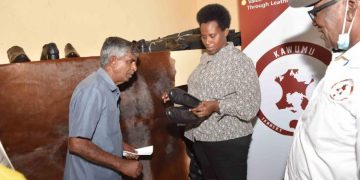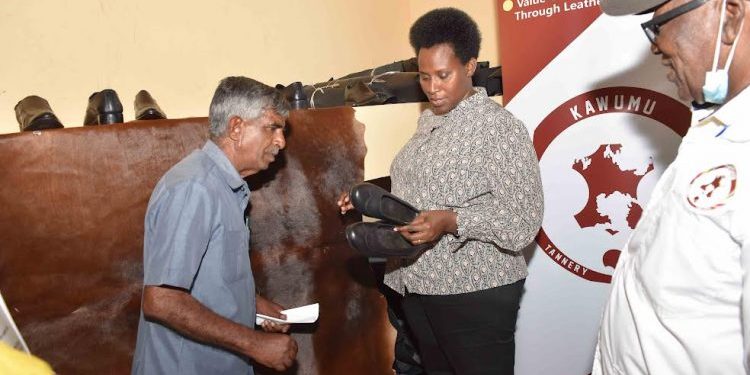President Yoweri Museveni has been hailed for his value addition vision that led to the setting up of a government owned state-of-the-art leather factory in Kawumu village, Luweero district.
Kawumu Tannery Uganda adds value to animal hides and skins.
The President was commended by a delegation from the Common Market for Eastern and Southern Africa (COMESA) who had paid a visit to the Tannery on Thursday.
The delegation full of experts in the leather industry with representatives from Ethiopia, Kenya, Rwanda, Burundi, Zimbabwe, Eritrea and Malawi are in Uganda for their 13th Annual Regional Consultative Forum of the Africa Leather and Leather Products Institute.
They described Kawumu Tannery located at the Presidential demonstration farm in Makulubita sub county, Luweero district as a confirmation that Africa is moving forward.
“When you see what’s happening here, it is very good for our growth. We are moving away from saying we are going to do it, now we are doing it. This is a real confirmation that whatever we want to do as Africans, it can be done,” said Mr. Charles M. Ndungu, a delegate from Kenya.
The 12 billion Shillings facility that was commissioned by President Museveni in October this year sits on 10 acres of land with an expansion plan which will cover an additional 10-acres.
The State House comptroller Ms. Jane Barekye welcomed the COMESA delegation to Kawumu Leather Tannery saying their visit will help Uganda improve her leather production.
She informed the team that despite its infant stages, the factory has shown a lot of potential because the leather produced is on high demand.
“We have managed to produce and sell. If we go to 10 tonnes per day, we shall need more market and machines of high technology and now that you’re here you’re going to help us,” Ms. Barekye said, adding that, the factory has managed to fulfill the objectives for which it was established which include among others adding value to leather, substituting the importation of leather products into the country and to promote exports of leather products.
She added that in future, a shoe making factory is going to be established to expand the value addition vision of the President and job creation.
“It’s not just a matter of hosting you but we want to learn from each other. We want to have some knowledge from you on how we can make it,” Ms. Barekye further noted.
From Zambia, Prof. Stiwala Mundia who was equally impressed by the facility, pledged to work with the government of Uganda in terms of research and called upon the COMESA region to work as a team and fill up the markets.
“We are ready to work with you in terms of research because we have travelled in Africa and we have realized that its only research that will move Africa forward. We have taken pictures of this infrastructure, and as we get back to our homes in Zambia we shall report that Uganda is moving forward,” Prof Mundia said.
The commissioner Ministry of trade, Dr Joshua Mutambi on behalf of the Ministry of trade responsible for value addition reported that the delegation had fruitful discussions at the just concluded Regional Consultative Forum that was under the theme: “Enhancing market access of leather and leather products through integrated application of eco-certification, possibility and standards around the value chain”.
The objectives of the forum included among others; sharing research undertakings by identified players on regional and global level, identifying the key challenges and interventions towards achieving sustainable regional leather sector development and discussing the potential pathway, capacity building and technology transfer from both regional and global perspectives.
He thanked the State House comptroller for allowing the delegation to visit the tannery.
“We thank you so much because we could not leave the delegation to go back without seeing the state of art of the leather tannery that his Excellency the President put up,” Dr Joshua said.
Mr. Abdul Hakim Ssekandi who is serving as board member of Africa Leather Institute and also chairman of the Leather Industry in Uganda commended the government of Uganda for the great strides made so far in developing the leather industry saying it is a sign that the dream of adding value to leather has come to reality.
He noted that Uganda by 1998 had only two (2) privately owned tanneries one in Jinja and Masaka all nowhere next to value addition but since then, through their advocacy role, Uganda now has 8 tanneries including the one in Kawumu owned by the government of Uganda.
He thanked the state house comptroller for the efforts to develop the leather industry and promised support from the private players.
“It is through you and your efforts that this project has come to see the light of the day. We assure you that all the turners are not here for competition. We are ready to cooperate, compliment and collaborate,” Mr. Abdul Hakim Ssekandi said, adding that with support of the government to the private players, the challenges facing the leather industry in Uganda will be history.
He called upon the government to implement the value chain strategy passed in 2015 which will soon be reviewed.
“If the government looks at that strategy, and implements it, the sector in Uganda will be another thing to talk about,” Mr. Ssekandi added.
Finished leather is capable of being fashioned into a wide range of products which include among others; shoes and boots, belts, gloves, luggage purses, and recreational equipment as well as industrial items like buffing wheels and machine belts.
President Museveni has on several occasions boasted of being the leading promoter of value addition to goods produced in Uganda, despite pulling ropes with what he termed as “parasites who work for foreign interests and political actors”.
Kawumu leather factory is run by Engineer Roy Kathavarayan, an Indian with 40 years of experience in the leather industry.








